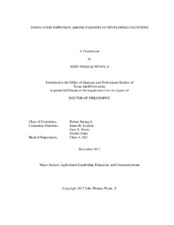| dc.description.abstract | Agriculture plays a fundamental role in the global economy. To accomplish the economical and feasible improvement in agricultural production, a more complete understanding of how innovations move through different channels is necessary. Farmers in developing countries have many disadvantages, including barriers to innovation exchange. Better understanding the diffusion process in developing countries is necessary to improve adoption. The framework utilized by this study is Rogers’ Diffusion Theory. The diffusion process in developing communities is equivalent to that of classical theory but with more emphasis placed on the knowledge, persuasion, and decision components as needs by the adopters. The purpose of this study was to describe the adopter characteristics of agriculturists, the innovation traits that facilitate adoption, and the adoption process itself, and identify the elements and barriers of information transmission in Brazil.
A questionnaire consisting of eight attitudinal constructs and one demographic construct was administered to 344 participants in this study. Each of the constructs had a Cronbach’s Alpha greater than 0.7. Data were analyzed using descriptive and correlational statistics, including stepwise regression. Respondent demographics showed that 22% of the sample was female and the average age for the respondents was 41 years. Adopter characteristics were identified as educated, more conscious of social status, more able to grasp and use a technology, and likely to be opinion leaders. Innovation characteristics conducive to adoption were innovations that were simple, easily communicable, socially accepted, and had high levels of utility to the individual. The adoption process was found to be consistent with Rogers’ characterization of agricultural producers. The elements of transmission that contributed to adoption were high levels of observability, compatibility and low complexity. The identified barriers to transmission were high complexity and low compatibility innovations.
Recommendations for practitioners to facilitate adoption were to target opinion leaders, minimize complexity, and increase education. Recommendations for future research included replication of the study in the same population and also in neighboring populations. Future research should explore the impacts of societal factors, increased education, and the ability to quantify innovation traits. | en |


